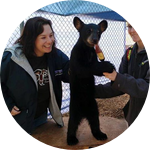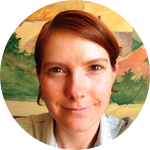About This Project
Why does innovation evolve? We humans are extremely innovative, but there are multiple pressures in our evolutionary history that could have selected for it. We're going to examine both sociality and foraging complexity as evolutionary pressures that select for innovation across species. By giving bears (Ursidae) and cats (Felidae) a puzzle box with multiple solutions, we'll shed light on this evolutionary conundrum.
Ask the Scientists
Join The DiscussionWhat is the context of this research?
Some carnivores are extremely social; others are loners. Some carnivores will eat almost anything; others depend on only one or two food sources. These traits, sociality and foraging, are thought to play a large role in the evolution of intelligent abilities across humans, primates, and birds. However, because most of these species are both highly social and have complex foraging, it is still hotly debated which of the two is more important (if either). The Carnivora have been historically neglected in studies of intelligence, yet now they represent an excellent group in which to re-examine this question. By studying the differences in intelligent abilities between species within Carnivora, we will help elucidate the roles of sociality and foraging in the evolution of intelligence.
What is the significance of this project?
Not only does this research impact our knowledge about the roles of sociality and foraging in the evolution of intelligence, but it could indirectly impact animals in the wild.
Conservation: Innovation is a key trait that influences how species adapt to changing environments. Knowing the differences between innovative abilities in endangered and threatened species can help us predict which ones will need the most help as their habitats change due to growing human populations.
Harmony: Human-carnivore conflicts are increasing, and some result in physical violence to humans and human structures. Understanding the innovative abilities of large carnivores can help us figure out which species are most likely to get into trouble with humans, and how to keep our interactions safe.
What are the goals of the project?
Our goal is to use one key aspect of intelligence, innovation, to evaluate hypotheses on the evolution of intelligence. To do this, we're using a multi-access box with food that can be obtained in 4 ways. Animals must repeatedly innovate to learn all 4 solutions.
Our first step is to visit the Cheyenne Mountain Zoo to study grizzly bears, Asiatic black bears, spectacled bears, mountain lions, Canada lynxes, African lions, Amur tigers, pallas cats, and snow leopards. We are also developing collaborations with other zoos to study giant pandas, sun bears, American black bears, and polar bears.
After collecting data from many species, we can see the degree to which social or foraging factors influence innovation within Carnivora.
Budget
The puzzle box is already built, we just need to get it (and me) to the Cheyenne Mountain Zoo for our first round of testing. I'm planning on being there on June 29 and 30 to drop off the box and get the zoo ready to begin testing. To get there, I'll have to leave on June 27 (it takes two days to get there from Rochester, MI). Our collaborator at the zoo has offered to host me while there, so I'll only need to stay in a hotel for two nights. That's it!
Endorsed by
Meet the Team
Team Bio
I started studying animal cognition and intelligence during my undergraduate experience at Bard College, where I had the opportunity to test the problem-solving abilities of a New Zealand parrot, the kea. This catapulted me directly into thinking about the nitty gritty questions of animal intelligence, and I haven't stopped since! Now I'm a second year graduate student in the Psychology PhD program at Oakland University. As well as this project, I'm researching the physical problem solving skills of striped skunks, the mood biases and photograph recognition of an American black bear, and if gorillas and black bears can spatially represent numbers.
In my (non-existent) free time, I ride my horse, Jazz, through the Michigan woods with my twin sister. Being a twin has definitely influenced my passion for science. Growing up, the two of us dissected all of our differences, trying to pinpoint the exact environmental factor that caused it (e.g. she is 3 inches taller than me, probably due to her getting more nutrition in the womb). I also enjoy playing board games, hiking, camping, and trying to teach my dog how to play fetch.
Zoe Johnson-Ulrich
I started studying animal cognition and intelligence during my undergraduate experience at Bard College, where I had the opportunity to test the problem-solving abilities of a New Zealand parrot, the kea. This catapulted me directly into thinking about the nitty gritty questions of animal intelligence, and I haven't stopped since! Now I'm a third year graduate student in the Psychology PhD program at Oakland University. I started studying skunks in my second year here (September 2014) with a test of their visual acuity; that study was to help us better design puzzles for skunks. It turns out they have pretty poor vision, but still good enough to see large puzzles! We always try and use food rewards at least 1"x1" to ensure they can see the food.
As well as this project, I'm researching the innovative abilities of bears and cats, the mood biases and photograph recognition of an American black bear, if gorillas and black bears can spatially represent numbers, and mood biases in rescued and neglected horses.
In my (non-existent) free time, I ride my horse, Jazz, through the Michigan woods with my twin sister. Being a twin has definitely influenced my passion for science. Growing up, the two of us dissected all of our differences, trying to pinpoint the exact environmental factor that caused them (e.g. she is 3 inches taller than me, probably due to her getting more nutrition in the womb). I also enjoy playing board games, hiking, camping, and trying to teach my dog how to play fetch.
Project Backers
- 26Backers
- 134%Funded
- $804Total Donations
- $30.92Average Donation


